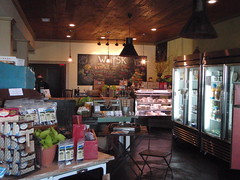 Carol Hazard wrote in the Richmond Times-Dispatch, March 21, 2011,
Organic, natural food catching on:
Carol Hazard wrote in the Richmond Times-Dispatch, March 21, 2011,
Organic, natural food catching on:
U.S. sales of organic foods and beverages grew from $1 billion in 1990 to $24.8 billion in 2009, according to the Organic Trade Association.The article didn’t link to the study, but here it is: Industry Statistics and Projected Growth.The sector saw double-digit growth — often more than 20 percent — every year over the past decade except 2009, at the tail-end of the recession. Even then, organic sales rose 5.9 percent from the previous year while total food sales increased only 1.6 percent.
Further from the Times-Dispatch article:
National grocers are pumping up their organic and natural food selections. Even Wal-Mart and its Sam’s Club warehouse division are paying attention.
“The entire movement is expanding,” said Jeffrey W. Metzger, publisher of Food World, a publication that follows the grocery market in the mid-Atlantic.If local grocers are going to sell natural and organic food, they need to get it from somewhere. How about from local growers? Lowndes County used to be a big center of agriculture. It could become a pioneer of local and organic agriculture for south Georgia.Five to seven years ago, conventional grocers devoted minimal space to natural and organic foods, he said. That changed as links became obvious between unhealthy eating and obesity, diabetes and other illnesses.
Even during the bottom of the recession, according to Lauren Hatch in The Recovery Times, Growing in the Recession:
The economic downturn may have forced the likes of Whole Foods and other high-end food shops to lower prices or reduce stores, but it has sparked a growth in urban farmers markets across the country. According to the U.S. Department of Agriculture, the numbers of farmers’ markets has jumped more than 16 percent this year to 6,100, or about 22 markets for every Whole Foods store. Overall, the number of farmers’ markets has tripled since the USDA began counting them in 1994.This is the time for farmers’ markets and local agriculture. Not only is local and organic food healthier, it tastes better. Plus the creative people we want to attract for knowledge-based businesses like and often expect local and organic food.
The last word from the Times-Dispatch article (I added the link):
Paige Bishop, spokeswoman for Ellwood Thompson’s, attributed industry growth to greater awareness that eating better is a form of health insurance. “The tide is changing,” she said, as people realize the health risks associated with ingesting toxic chemicals, genetically modified organisms and antibiotics.Americans spend 7 percent of their disposable income on food, the lowest percentage in the world, Wolf said. “In a lot of ways, we can’t afford not to buy healthy foods.”
-jsq
Short Link: